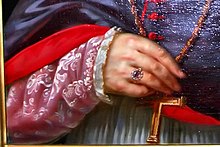
An ecclesiastical ring is a finger ring worn by clergy, such as a bishop's ring.

An ecclesiastical ring is a finger ring worn by clergy, such as a bishop's ring.


In Western Christianity, rings are worn by bishops of the Roman Catholic, Anglican and other denominations. Eastern Orthodox bishops do not normally wear rings, but some Eastern Catholic bishops do.[ citation needed ]
A bishop is given a ring at his consecration by his consecrator. He is also free to subsequently obtain and wear his own episcopal rings. The style of the episcopal ring has almost always been very large, gold, stone-set ring. Roman Catholic bishops traditionally have their episcopal ring set with an amethyst. [1]
Aside from the rings a bishop purchases or is given by others, his rings belong to the Church; he will have inherited the previous bishop's ring collection, which is held in trust. While all hierarchs are accorded the honor of being buried wearing a ring, all rings belonging to the Church will be returned to the Church upon the retirement or death of any hierarch. [2]
In a decree of Pope Boniface IV (AD 610) it describes monks raised to the episcopal dignity as anulo pontificali subarrhatis, while at the Fourth Council of Toledo, in 633, it was stated that if a bishop has been deposed from his office and afterwards reinstated, he is to receive back stole, ring and crosier (orarium, anulum et baculum). St. Isidore of Seville, at about the same period, couples the ring with the crosier and declares that the former is conferred as "an emblem of the pontifical dignity or of the sealing of secrets". [3] The ring is strictly speaking an episcopal ornament conferred in the rite of consecration, and that it was commonly regarded as emblematic of the mystical betrothal of the bishop to his church.
In the eighth and ninth centuries in manuscripts of the Gregorian sacramentary and in a few early pontificals (e.g., that attributed to Archbishop Egbert of York) there are various formulae for the delivery of the ring. The Gregorian form, which survives in substance to the present, runs in these terms: "Receive the ring, that is to say, the seal of faith, whereby thou, being thyself adorned with spotless faith, mayst keep unsullied the troth which thou hast pledged to the spouse of God, His Holy Church."[ citation needed ]
Royal as well as religious seals (signet ring), indicative of discretion and conjugal fidelity, dominate the symbolism of the ring. In the case of bishops, "a bishop deserting the Church to which he was consecrated and transferring himself to another is to be held guilty of adultery, and is to be visited with the same penalties as a man who, forsaking his own wife, goes to live with another woman." [4] Perhaps this idea of espousals helped to establish the rule, mentioned first in the ninth century, that the episcopal ring was to be placed on the fourth finger (the ring finger) of the right hand.
Since episcopal rings had to be worn on ceremonial occasions on the outside of the pontifical glove and prelates' gloves, it is common to find medieval specimens extremely large in size and disproportionately heavy. The inconvenience of the looseness was corrected by placing another smaller ring just above it as a ring guard. [5] It was quite common for bishops and popes to wear other rings along with the episcopal ring; the 1882 edition of Caeremoniale episcoporum (Book II, viii, nn. 10–11) still assumed that this was likely to be the case.

Tradition prescribed that a layman or a cleric of inferior grade on being presented to a bishop should kiss his hand (called baciamano in Italian), which is to say, an obligation to kiss the episcopal ring. Before the promulgation of the 1967 Enchiridion Indulgentiarum , an indulgence of 50 days resulted from this act. It is still arguable that an indulgence may be received if the ring is considered an object of piety, as kissing an object of piety carries a partial indulgence.
Episcopal rings, both at an earlier and later period, were sometimes used as receptacles for relics. Traditionally, three rings were bestowed: the pontifical, the gemmed, and the ordinary. In recent decades, most bishops have only received one ring for the sake of reducing costs.[ citation needed ]
Modern episcopal rings have a special sliding-band inner mechanism that allows them to be sized and locked into place, eliminating the need to have rings sized or resized. Ludovic Taurin-Cahagne, Bishop of Adramythe in Ethiopia, Apostolic Vicar of the Gallas, c. 1875, had a unique ring that locked and unlocked, apparently an early form of adjustability (and perhaps a security mechanism). [6] Cardinal O'Malley's ring, conferred by Pope John Paul II, could be opened from the back and resized. [7]
There are times when a bishop may be awarded an episcopal ring with a form of a coat of arms or specific Catholic symbol, such as the ring given to Bishop Henessy of Boston. [8]
Cardinals have the privilege of wearing pontifical vestments, including the ring, even if they are not themselves consecrated as bishops. [9] The privilege of wearing a ring has belonged to cardinal-priests at least since the time of Innocent III. [10]
Cardinal bishops and cardinal priests are conferred a ring by the pope himself in the consistory, in which the new cardinal is named to a particular titular church (for a cardinal priest) or suburbicarian diocese (for a cardinal bishop) and elevated to the cardinalate. The pope determines the style of this ring. In the past, a cardinal's ring could be set with a sapphire, while it bore on the inner side of the bezel the arms of the pope conferring it. The solid gold cardinal's ring chosen by John Paul II bears an oblong crucifixion scene. [11] Pope Benedict XVI used the same at first, but chose a new design from the consistory of 2012. [12]
The episcopal ring of the pope is known as the Ring of the Fisherman (Latin : Annulus Piscatoris). Originally the pope's episcopal ring as the Bishop of Rome, it has since become a symbol of papal authority. The origin of the ring design is inspired by Jesus telling St. Peter, who was by trade a fisherman, "I will make you a fisher of men."
The Ring of the Fisherman is a large gold ring with a round or, more recently, an ovoid, bezel. As recently as the 1970s, it was a large medallion shape. On the face appears the image of St. Peter in a fishing boat on the water; above him is the chosen name of the pope. Upon the death or resignation of a pope, the ring is broken. [13]
Some abbots were given the privilege of wearing pontifical vestments reserved only to bishops by virtue of their office within monasteries. Certain abbesses have also received such a privilege. As part of this privilege of wearing pontifical accoutrements, both abbots and abbesses wear a ring. The blessing and delivery of a ring has formed part of the rite for the blessing of an abbot or an abbess.[ citation needed ]
This section needs additional citations for verification .(February 2024) |
Certain other offices within the Catholic Church are given the privilege of wearing rings even if they do not partake of the privilege of pontifical vestments. In the Roman Catholic Church, the privilege to wear a ring indicates the papal recognition and granting of authority to wear such a ring. [14] Such rings cannot ordinarily be worn by these minor prelates during the celebration of Mass.
Minor prelates like protonotaries apostolic may wear them, while some canons may also wear them with special papal indult. [15]
In the Order of Preachers, the honorary title of Master of Sacred Theology, roughly equal to an honorary doctorate in theology, includes the privilege of wearing a non-liturgical ring, which may be set with an amethyst. It is not unusual for the ring to be inscribed inside the band with the initials of the previous Masters of Sacred Theology of the province.
The tradition of wedding bands worn by certain nuns and consecrated virgins conferred upon them in the course of their solemn consecration of virginity, according to the rite of consecration provided in the Roman pontifical is found in ancient tradition. Ambrose of Milan speaks as though it were customary for consecrated virgins to wear a ring as a sign of their betrothal to Jesus Christ, their heavenly spouse. [16] This bestowal of a ring to nuns with solemn vows is also mentioned by several medieval pontificals, from the twelfth century onwards.
The Marianist brothers wear a signet ring representing the vows they made, [17] while the Benedictine Sisters of Perpetual Adoration wear a ring as part of their religious habit. [18] The Order of Clerks Regular of St. Viator wear a ring and are also permitted, by papal indult, to wear the ring of investiture even during Mass.
This section needs additional citations for verification .(February 2024) |
Wedding rings, or more strictly, rings given in the betrothal ceremony, were common among Christians under the Roman Empire from an early period. The use of such rings was of older date than Christianity, and there is not much to suggest that the giving of the ring was at first incorporated in any ritual for laypeople, or invested with any precise religious significance. It is known from archeological finds that the betrothal/wedding ring was adorned with Christian emblems. Certain specimens prove this today, such as a gold ring found near Arles, from circa the fourth or fifth century AD, and bearing the inscription Tecla vivat Deo cum marito seo [suo].
In the coronation ceremony too, it has long been the custom to deliver both to the sovereign and to the queen consort a ring previously blessed. Perhaps the earliest example of the use of such a ring is in the case of Judith, the stepmother of King Alfred the Great, but it is unclear whether that ring was bestowed upon the queen in virtue of her dignity as queen consort or of her nuptials to King Æthelwulf of Wessex.
For the year of his office the Moderator of the General Assembly of the Church of Scotland (chairman of the General Assembly) wears an amethyst and gold ring. The stone has incised on it the crest of the Church of Scotland – a burning bush – and around it the words "Nec Tamen Consumebatur" ("Burning but not being consumed"). The words refer to Moses' encounter with the burning bush in the desert. Each year as the retiring moderator installs his successor in office, he places the ring on the new moderator's finger.
Other religious rings:
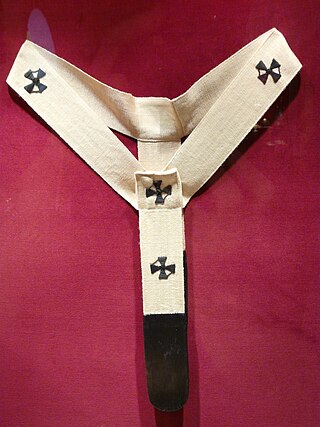
The pallium is an ecclesiastical vestment in the Catholic Church, originally peculiar to the Pope, but for many centuries bestowed by the Holy See upon metropolitans and primates as a symbol of their conferred jurisdictional authorities, and still remains a papal emblem.

A papal coronation is the formal ceremony of the placing of the papal tiara on a newly elected pope. The first recorded papal coronation was of Pope Nicholas I in 858. The most recent was the 1963 coronation of Paul VI, who soon afterwards abandoned the practice of wearing the tiara. To date, none of his successors have used the tiara, and their papal inauguration celebrations have included no coronation ceremony, although any future pope may elect to restore the use of the tiara at any point during his pontificate.
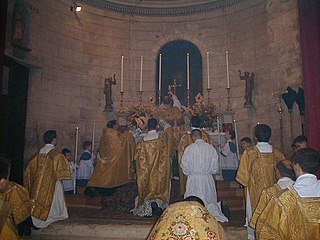
Vestments are liturgical garments and articles associated primarily with the Christian religion, especially by Eastern Churches, Catholics, Lutherans, and Anglicans. Many other groups also make use of liturgical garments; among the Reformed (Calvinist) Churches this was a point of controversy in the Protestant Reformation and sometimes since, in particular during the ritualist controversies in the Church of England in the 19th century.

A Pontifical High Mass, also called Solemn Pontifical Mass, is a Solemn or High Mass celebrated by a bishop using certain prescribed ceremonies. Although in modern English the word "pontifical" is almost exclusively associated with the pope, any bishop may be properly called a pontiff. Thus, the celebrant of a Pontifical High Mass may be the pope, any bishop or any other prelate who is allowed to wear pontificals.

The mitre or miter is a type of headgear now known as the traditional, ceremonial headdress of bishops and certain abbots in traditional Christianity. Mitres are worn in the Catholic Church, Eastern Orthodox Church, Oriental Orthodox Churches, the Anglican Communion, some Lutheran churches, for important ceremonies, by the Metropolitan of the Malankara Mar Thoma Syrian Church, and also, in the Catholic Church, all cardinals, whether or not bishops, and some Eastern Orthodox archpriests.

The cope is a liturgical vestment, more precisely a long mantle or cloak, open in front and fastened at the breast with a band or clasp. It may be of any liturgical colour.

A Papal Mass is the Solemn Pontifical High Mass celebrated by the Pope. It is celebrated on such occasions as a papal coronation, an ex cathedra pronouncement, the canonization of a saint, on Easter or Christmas or other major feast days.

Papal regalia and insignia are the official items of attire and decoration proper to the Pope in his capacity as the visible head of the Catholic Church and sovereign of the Vatican City State.
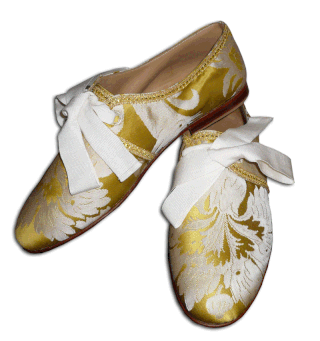
Episcopal sandals, also known as pontifical sandals, are a Catholic pontifical vestment worn by bishops when celebrating liturgical functions according to the pre–Vatican II rubrics, for example a Tridentine Solemn Pontifical Mass.

A cappello romano or saturno is a clerical hat with a wide, circular brim and a rounded crown worn outdoors in some countries by Catholic clergy, when dressed in a cassock.

A pectoral cross or pectorale is a cross that is worn on the chest, usually suspended from the neck by a cord or chain. In ancient history and the Middle Ages, pectoral crosses were worn by both clergy and laity. By the Late Middle Ages, the pectoral cross came to be a special indicator of position worn by bishops. In the Roman Catholic Church, the wearing of a pectoral cross remains restricted to popes, cardinals, bishops and abbots. In Eastern Orthodox Church and Byzantine Catholic Churches that follow a Slavic Tradition, priests also wear pectoral crosses, while deacons and minor orders do not. The modern pectoral cross is relatively large, and is different from the small crosses worn on necklaces by many Christians. Most pectoral crosses are made of precious metals and some contain precious or semi-precious gems. Some contain a corpus like a crucifix while others use stylized designs and religious symbols.

The Papal shoes are the red leather outdoor shoes worn by the Pope. They should not be confused with the indoor Papal slippers or the Episcopal sandals, which are the liturgical footwear proper to all ordained Catholic bishops of the Latin Church.
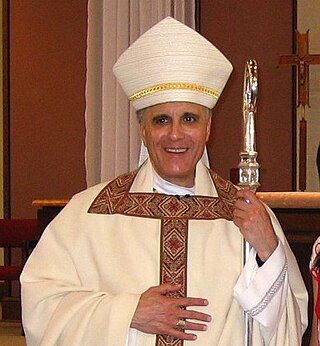
Daniel Nicholas DiNardo is an American cardinal of the Catholic Church. He is the second and current archbishop of the Archdiocese of Galveston-Houston in Texas serving since 2006. He previously served as bishop of the Diocese of Sioux City in Iowa from 1998 to 2004.

The mozzetta is a short elbow-length sartorial vestment, a cape that covers the shoulders and is buttoned over the frontal breast area. It is worn over the rochet or cotta as part of choir dress by some of the clergy of the Catholic Church, among them the pope, cardinals, bishops, abbots, canons and religious superiors. There used to be a small hood on the back of the mozzetta of bishops and cardinals, but this was discontinued by Pope Paul VI. The hood, however, was retained in the mozzette of certain canons and abbots, and in that of the popes, often trimmed in satin, silk or ermine material.
A mantelletta, Italian diminutive of Latin mantellum 'mantle', is a sleeveless, knee-length, vest-like garment, open in front, with slits instead of sleeves on the sides, fastened at the neck. It was for a period of time even more common than the mozzetta.
Francis Frederick Reh was an American prelate of the Roman Catholic church. He served as bishop of the Diocese of Charleston in South Carolina from 1962 to 1964.

In the Catholic Church, a bishop is an ordained minister who holds the fullness of the sacrament of holy orders and is responsible for teaching doctrine, governing Catholics in his jurisdiction, sanctifying the world and representing the Church. Catholics trace the origins of the office of bishop to the apostles, who it is believed were endowed with a special charism and office by the Holy Spirit at Pentecost. Catholics believe this special charism and office has been transmitted through an unbroken succession of bishops by the laying on of hands in the sacrament of holy orders.
Pontifical vestments, also referred to as episcopal vestments or pontificals, are the liturgical vestments worn by bishops in the Catholic, Eastern Orthodox, Oriental Orthodox, Anglican, and some Lutheran churches, in addition to the usual priestly vestments for the celebration of the mass, other sacraments, sacramentals, and canonical hours. The pontifical vestments are only worn when celebrating or presiding over liturgical functions. As such, the garments should not be confused with choir dress, which are worn when attending liturgical functions but not celebrating or presiding.

Daniel Anthony Cronin is an American prelate of the Roman Catholic Church. He served as an auxiliary bishop of the Archdiocese of Boston from 1968 to 1970, as bishop of the Diocese of Fall River in Massachusetts from 1970 to 1992, and as archbishop of the Archdiocese of Hartford in Connecticut from 1992 to 2003.
Joseph Francis Flannelly was an American clergyman of the Roman Catholic Church. He served as an auxiliary bishop of the Archdiocese of New York from 1948 to 1969.
The papal ring will be destroyed, along with other powerful emblems of authority, just as they are after a pope's death.
The sole common habit of the Marianist brother is the gold ring he wears from the time of perpetual profession.
Sisters receive a ring at Final Monastic Profession.